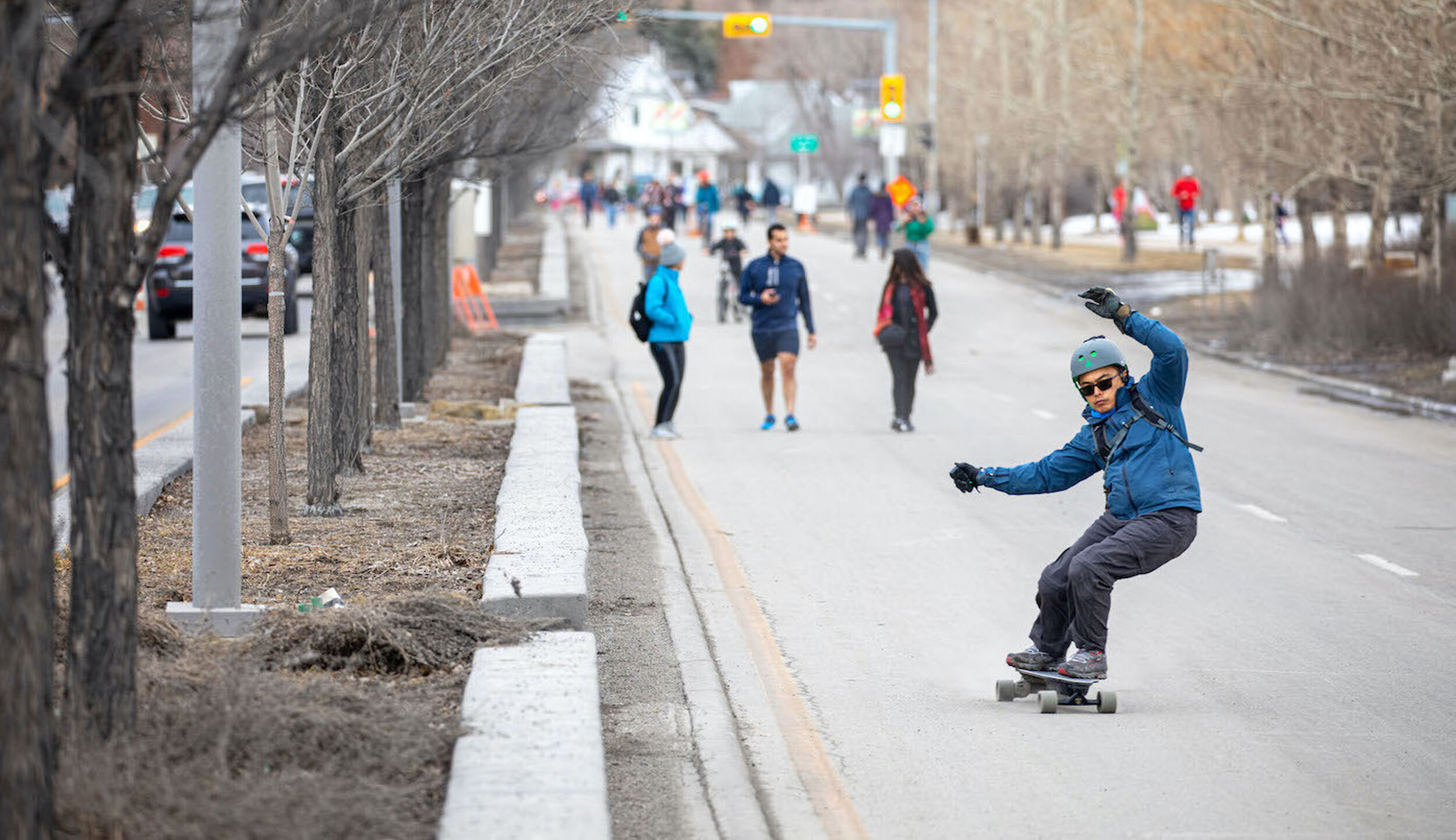
Calgarians out enjoying Memorial Drive on the weekend. Photo: Neil Zeller
In dark times, we’re building hopeful new norms
Urban life in a pandemic is hard — but has silver linings.
For the past few years, I’ve led a crowd of strangers through my neighbourhood on a Jane’s Walk. On the first weekend of May, each year we’ve met at the Sunnyside art car, a local landmark, and toured through quirk and character in the community, from colourful painted garage doors to a front yard miniature museum.
Jane’s Walk is an annual festival of free, citizen-led walks held in communities around the world. The walks, inspired by the late urban activist and author Jane Jacobs, are always held near Jacobs’ birthday on May 4. People join these walks to hear stories, learn about their city and connect with others.
In response to the COVID-19 pandemic, this year’s Jane’s Walk has been cancelled in Calgary, and understandably so. Even the thought of it, a horde of people walking closely together, now gives me an uncomfortable feeling.
How quickly life has changed in a few weeks.
How can we still feel part of urban life in Calgary right now?
At first, seeing eerily empty CTrain cars passing through the Sunnyside station unnerved me. Same with walking in Kensington, now a sudden ghost town just like so many other main streets in Calgary and around the world.
Cities are designed for social interactions. Existing in a city under our current orders—to stay home as much as possible, to physically distance ourselves from others when we do leave—feels jarring. How can we still feel part of urban life in Calgary right now?
In a recent piece for The New York Times, Can City Life Survive Coronavirus?, architecture critic Michael Kimmelman explains how the virus undermines our most basic ideas about community and urban life.
“Cities are epicenters of capital and creativity, designed to be occupied collectively. Pandemics are anti-urban, preying on our human desire for connection,” Kimmelman writes.
In contrast, Doug Saunders, international affairs columnist at The Globe and Mail, offers a different take in Run from the hills: In a pandemic, big cities are islands of safety. “When a pandemic comes,” he writes, “cities scare the hell out of people.” But “the biggest cities are also the safest places in the world. Only they have the infrastructure, staff and organization to really quash an outbreak.”
Here in Calgary, I am awkwardly adjusting to this new urban life, in which longstanding norms have been reversed. Hold the door open for a stranger at the grocery store? Nope, they’ll walk by you too close. Share pints with the neighbours at the local spot? Of course not. Stop to pet the neighbourhood cat? Nope.
But there are heartening new norms forming. Checking in with neighbours more often and finding new ways to connect. More smiles, nods and hellos with strangers. More space for people on foot and bikes.
On Saturday, I took a walk on Memorial Drive, one of six roads the City of Calgary has temporarily closed to give people living in dense areas more space for physical distancing.
“Woo-hoo!” exclaimed a passerby as he stepped onto the closed road with his dog.
I know I’m not alone in feeling joy in such simple interactions. I’ve seen Calgarians share how they’re collectively raising a glass of wine to their neighbours; putting Christmas lights back up for some extra cheer; participating in neighbourhood window walks; organizing balcony singalongs; and feeling more connected to their community than ever simply by sharing hellos.
These interactions are important, and I hope we don’t forget about them when normal city life resumes.
Let’s check in on our neighbours, listen more deeply and create new ways to connect.
I recently took a walk through my neighbourhood, tracing the path I’ve taken people on during my Jane’s Walk. Along the way, I paused to admire new messages from neighbours, including front steps that said, “Always on the Sunnyside” and a child’s sign that read, “Thank You Helpers.”
These may be small touches, but they feel monumental right now.
In an email from the Calgary Foundation announcing the cancellation of the Jane’s Walk festival, a reminder was offered of what the event is all about. “During this period of uncertainty, let’s look for ways we can bring the spark of Jane Jacobs into our lives. Let’s check in on our neighbours, listen more deeply and create new ways to connect,” wrote Julie Black, citizen engagement associate at the Calgary Foundation.
I have no idea when we will be able to once again lead and join Jane’s Walks in Calgary.
But when we do, I’m certain we’ll all have new stories to share: about how a pandemic transforms urban life, about the small acts of kindness that have big impacts, about why community matters so much.
Cailynn Klingbeil is a freelance journalist based in Calgary. Her writing has appeared in numerous publications including The New York Times, The Guardian, The Globe and Mail and CBC.
The Sprawl is crowdfunded, ad-free and made in Calgary. Become a Sprawl member today to support independent local journalism!
Support in-depth Calgary journalism.
Sign Me Up!We connect Calgarians with their city through in-depth, curiosity-driven journalism—but can't do this alone! We rely on our readers and listeners to fund our work. Join us by becoming a Sprawl member today!
